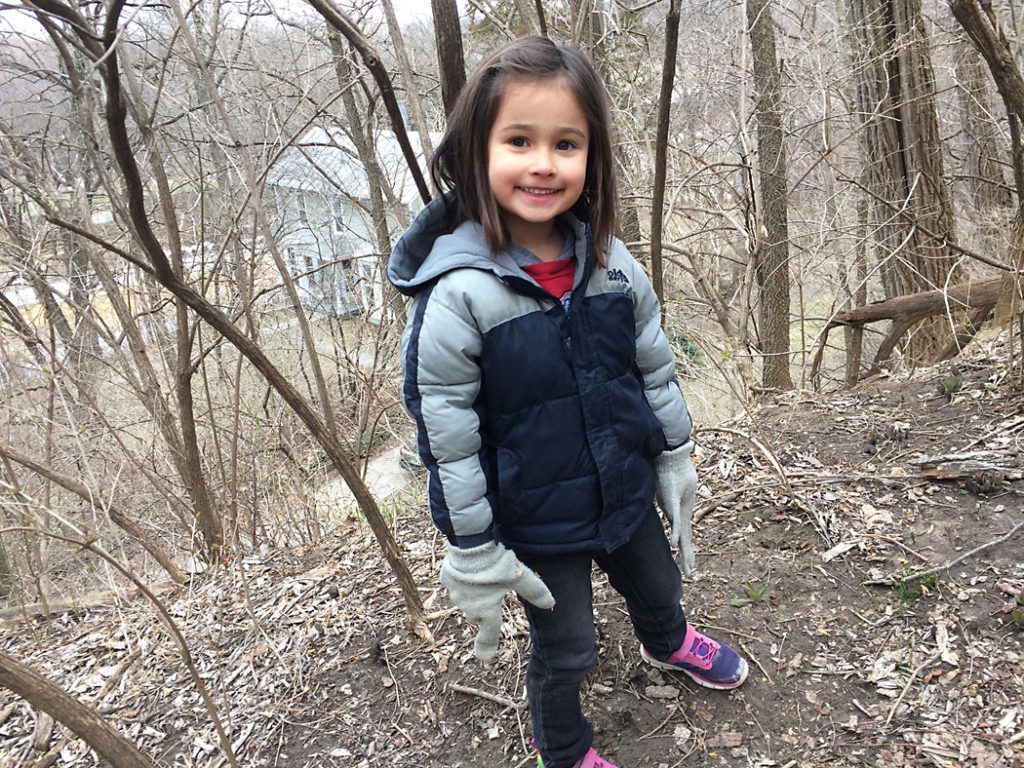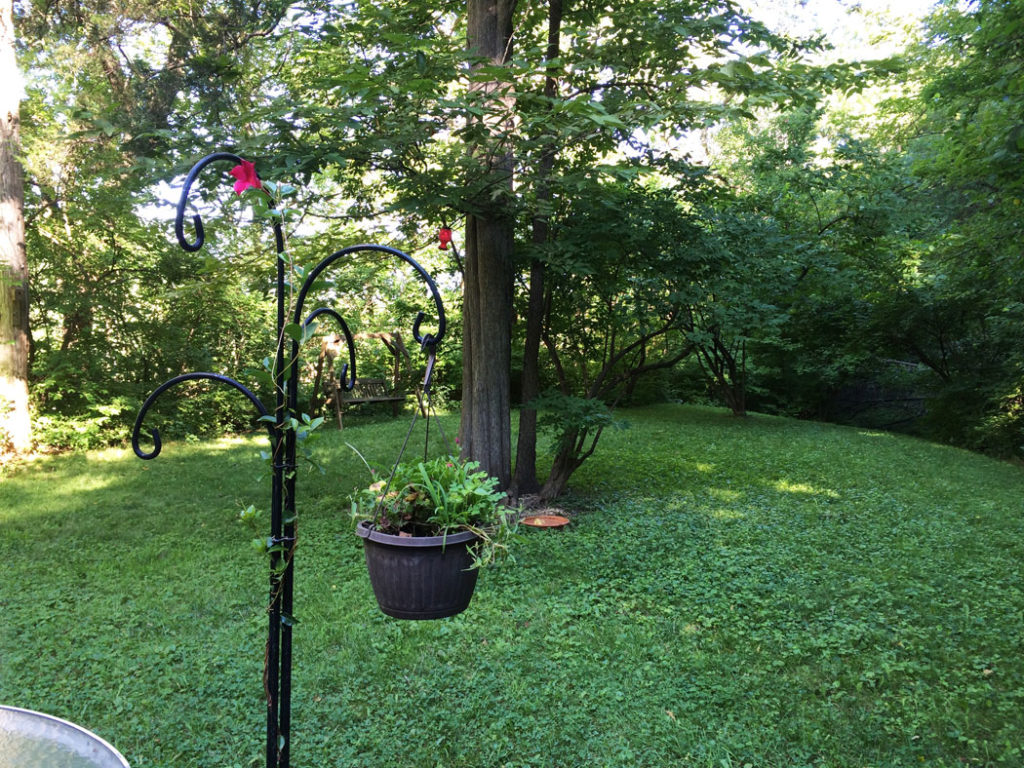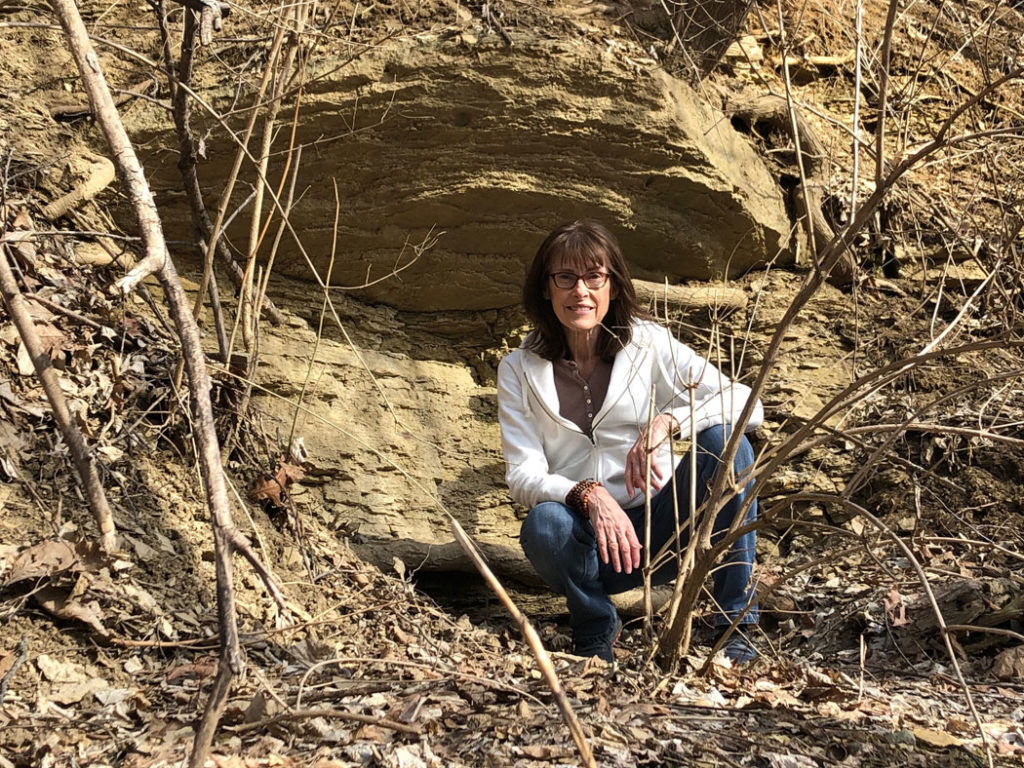
Our yard is one-third vertical. The wooded bluff behind our house—from which the limestone foundation was quarried 160-plus years ago—stays brown long after daffodils have poked up elsewhere in the yard. From November through March and into April, the bluff is a delightfully climbable tangle of tree trunks and bare branches and logs and roots and deer paths and limestone outcroppings and dead leaves. At sunset, when the last beams of light shoot straight across our yard to the bluff, everything brown turns to gold—a reddish gold that gets redder as the shadows lengthen and the sun drops lower into the trees on the other side of the Iowa River.
Then, one day in April, a green mist appears on the bluff. Buds on every kind of branch open into tiny leaves, on cue. By June, the vegetation is impenetrable—a lush three-story backdrop for fireflies.
The house itself sits with a patch of yard, front and back, on a kind of plateau shored up by low walls and piles of stones and bordered by trees. In summer, when everything is in full leaf, the patch of backyard that’s closest to the house is like a room with living walls of greenery. Stepping out the kitchen door, you would never guess that Dubuque Street is out there on the other side of the thicket of trees and shrubs. You can see the Iowa River from our backyard, but only in the leafless seasons.
There’s a break in the wall of trees on the north side of the plateau, where it slopes down at a modestly useful sledding angle to the lower part of the yard, which, for reasons I don’t remember or never knew, we call the sward. (Sounds like “sword” the way it should be pronounced, “w” and all.) Some might call our sward a lawn, but given all the bluebells and clover and dandelions and vetch and jacks in their pulpits, “lawn” seems less than accurate. We do mow it, though, after the bluebells are done, with what we call the lawn mower.

We call the old stone steps that descend from plateau to sward “the garden steps,” despite a distinct lack of “garden.”
At its northern end, where our yard begins to narrow and grow muddier, the sward is blocked by the Great Barrier Tree, a fallen mulberry. Deer and squirrels and our one fat woodchuck have no trouble scampering over it. Only humans—including grandchildren—find it a formidable obstacle.
We are an official National Wildlife Federation wildlife habitat. Yes, I made a donation and sent for the sign that we’ve posted (without harming the tree) for all the raccoons, possums, foxes, cats, squirrels, deer, bees, butterflies, and birds—especially the birds—to see.

In the flower-pots-turned-birdfeeders that hang from shepherd’s hooks not far from the kitchen door, we have at this very moment a sparrow (make that two sparrows—no, three), a chickadee, a tufted titmouse (come and gone and back again before I can get to the end of this sentence), and a lady cardinal who is turning around and around in the middle of the biggest hanging pot as if she’s thinking “nest.”
To the birds who mate for life I sometimes want to say, “Don’t do it!” I mean, it’s worked out all right for my husband and me, but then our species is higher on the food chain than the birds. When I looked out the back door one morning in time to see a fox trotting away with something bright red-feathered in its mouth, all I could think about was the lady cardinal sitting on eggs in a nest nearby, waiting for the breakfast that would never come. And few sights in the yard are sadder than an odd number of mourning doves pecking at the birdseed I’ve scattered under the cedar tree—especially when all but one of them fly away in pairs.

This morning, the long-haired semi-tamed calico that our neighbors call Peaches is sitting primly under a shelf of limestone halfway up the bluff, waiting for me to put cat food in the green dish at the bottom. I feed Peaches over there, at the edge of the sward, far from the flower pots and the cedar tree, and she leaves the birds alone. It’s a kind of extortion, I suppose.
I’ve never seen a cat carry off a bird in my yard, and I spend a lot of time here at the kitchen table near the windows, looking over the upper edge of my laptop screen at what’s going on in the yard. As much as I love the birds, I couldn’t begrudge the fox, who was feeding a pair of kits born recently in a hole on the far side of our driveway. And the hawk who swooped down on that unsuspecting mourning dove? Well, it’s a bird-feeding station, isn’t it? If I figured out a way to make it vegetarians only—no bugs, no grubs—about all I’d have left are the hummingbirds.
And speaking of DNA (weren’t we?), doesn’t the very idea that birds are descendants of the dinosaurs just thrill you to the core? We thought they were extinct—and here they are all around us!
I sit here in the kitchen and watch at least a dozen sparrows swoop as one from branches or roof to the birdseed under the cedar tree. Hopping over one another, splashing in the water dish, always moving, taking turns, sparrows are the hardest species to identify using the online lists for the Great Backyard Bird Count. Is that little guy an American tree sparrow (look for the black spot!) or a song sparrow or a chipping sparrow or a field sparrow?
They don’t care what we call them, amateurs that we are when it comes to surviving world-changing disaster. They found a way to stick around, these little dinosaurs, by becoming small and brown.
Mary Helen Stefaniak is the award-winning author of The Cailiffs of Baghdad, Georgia. She teaches fiction writing in the MFA program at Pacific University and in the International Summer School at Renmin University in Beijing.
